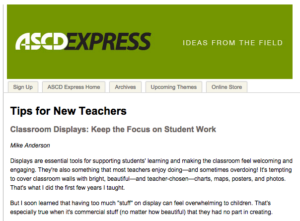Classroom Displays: Keep the Focus on Student Work
Original Article: http://www.ascd.org/ascd-express/vol6/613-anderson.aspx?utm_source=ascdexpress&utm_medium=email&utm_campaign=express613
 Displays are essential tools for supporting students’ learning and making the classroom feel welcoming and engaging. They’re also something that most teachers enjoy doing—and sometimes overdoing! It’s tempting to cover classroom walls with bright, beautiful—and teacher-chosen—charts, maps, posters, and photos. That’s what I did the first few years I taught.
Displays are essential tools for supporting students’ learning and making the classroom feel welcoming and engaging. They’re also something that most teachers enjoy doing—and sometimes overdoing! It’s tempting to cover classroom walls with bright, beautiful—and teacher-chosen—charts, maps, posters, and photos. That’s what I did the first few years I taught.
But I soon learned that having too much “stuff” on display can feel overwhelming to children. That’s especially true when it’s commercial stuff (no matter how beautiful) that they had no part in creating.
These days, when I’m visiting many classrooms as an elementary school consultant and coach, I’m more convinced than ever that classroom displays should consist mostly of work students have done themselves (along with a few essential informational pieces such as class rules, anchor charts, and reminders about classroom routines).
Now is a good time to pause and look at your classroom displays. Are they mostly student-generated? Are they organized in a way that invites children’s attention and enlivens their learning?
Tips for Better Displays
Here are some tips to help you assess and spruce up your displays.
Include everyone. Are all students represented in some way? All students need to know that their efforts are valued, so display work from every child, not just the “best” students.
Display drafts and polished pieces. Showcasing drafts and finished work side by side tells children that we value the process of learning as much as we value the products. It’s a great way to teach children that mistakes are an important part of learning, not something to be ashamed of or to hide. Teach children that a polished piece of writing next to a marked-up, crossed-out draft says, “Look how much I’ve grown!”
Ask for input from students. Giving students a say about what you showcase makes displays more interesting to them, reinforces their efforts, and fosters a feeling of community as they see that the classroom is something they create together.
Put pieces at eye level. That is, put pieces at the children’s eye level. They can’t enjoy looking at something they have to strain to see.
Choose the right space. Display paintings, writing samples, and other two-dimensional pieces on bulletin boards and other wall spaces. Keep the tops of bookshelves clear for three-dimensional work such as dioramas and models. If you can, create a little more display space with simple wire shelving (either freestanding or wall-mountable) from a hardware store.
Control clutter. Leave ample blank space around everything you display. If you have no room for blank space, put up fewer displays or put fewer pieces in each display. You can always post items in rotation. Remember, too, that less is always more where displays are concerned. Overdoing displays, even those of students’ work, can overstimulate children and interfere with your efforts to create a calm classroom environment.
Keep displays fresh. After displays have been up for a couple of weeks, students generally stop looking at them. Be vigilant about taking down work that’s no longer relevant.
Sending a Message with Displays
Displaying student work sends several important messages to students, staff, and visitors:
- As teachers, we value what students do.
- This is the students’ classroom as much as the teacher’s.
- In this classroom, students share their work and learning with one another.
Students will naturally look at their own work more frequently than they’ll look at commercial pieces. It is theirwork, after all. Seeing their own work on display not only boosts students’ sense of belonging and significance in the room, but also helps them learn from their classmates and see a greater purpose behind their work. All of these things can help lead to greater academic engagement and deep, meaningful learning.




